The Best Ideas for Creating a Beautiful Tiered Garden
Tiered gardens are a brilliant way to transform sloped or uneven landscapes into breathtaking outdoor spaces. Their structured layers create visual interest while serving practical purposes, such as soil stabilization and water management. Whether you have a small yard or a sprawling slope to work with, a tiered garden offers the opportunity to enhance your space’s beauty and functionality.
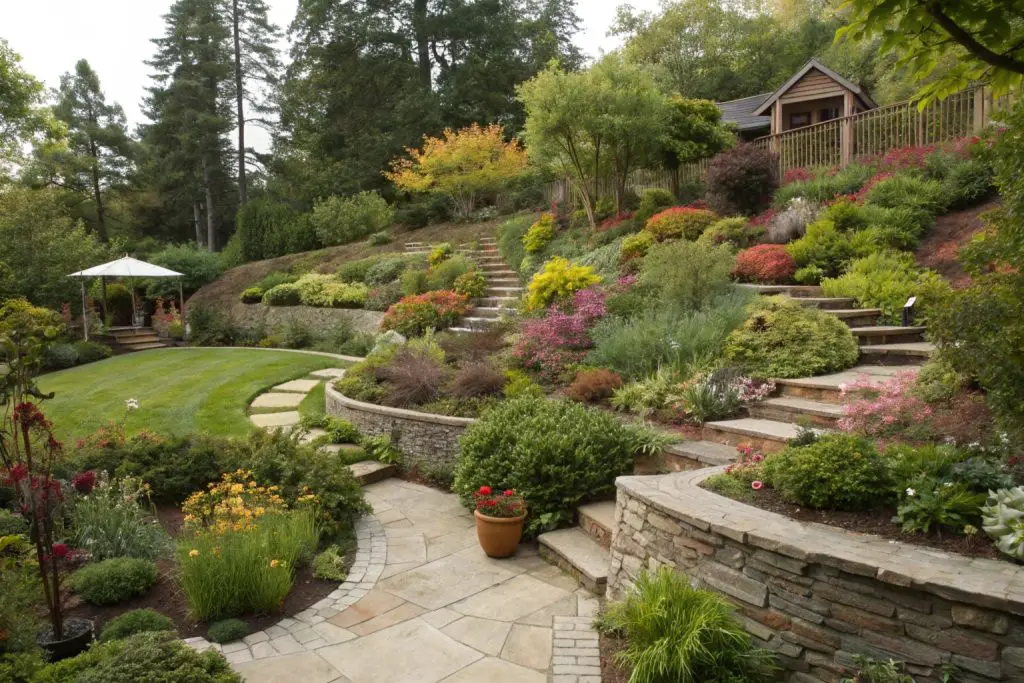
Below, we will explore the many facets of designing and creating a tiered garden. From the basics of structure to innovative features and cost-saving ideas, we’ll uncover how tiered gardens can work for any space or budget. Along the way, we’ll highlight tips and insights to inspire you to turn your outdoor space into a show-stopping garden.
Benefits of Tiered Gardens
Tiered gardens aren’t just visually stunning; they also come with a host of benefits. On sloped landscapes, tiers help manage water flow, preventing soil erosion and ensuring that plants receive consistent hydration. They also allow for efficient use of space by creating distinct areas for planting, walking, or simply enjoying the view. Additionally, the layered structure adds depth and dimension, making even a small garden feel larger and more dynamic.
Understanding Tiered Garden Basics

What Is a Tiered Garden?
At its core, a tiered garden is a series of stepped or layered planting beds. These tiers are typically built into sloped or uneven terrain to make the space usable and attractive. Each tier functions as its own planting zone, allowing for creative combinations of plants, flowers, or even vegetables.
The structure of a tiered garden also serves functional purposes. For instance, tiers can slow down water runoff, reducing the risk of erosion. They also create a micro-climate for plants, as the walls of the tiers retain heat, extending the growing season in cooler areas.
Design Principles for Tiered Gardens
Designing a tiered garden involves more than just stacking soil and plants. To create a garden that feels cohesive and appealing, it’s essential to focus on key design principles:
- Balance and Symmetry: Ensure the tiers are evenly spaced and proportioned to create a sense of harmony.
- Flow: Incorporate paths or steps between tiers to make the garden easy to navigate and visually cohesive.
- Plant Height and Placement: Use taller plants at the back or top tiers and shorter ones in the front to maintain sightlines and balance.
- Materials: Choose materials for retaining walls and borders that complement your home’s exterior or existing garden features.
Why These Basics Matter
Understanding these foundational aspects sets the stage for a successful project. A well-planned tiered garden isn’t just beautiful—it’s also easier to maintain, lasts longer, and makes the most of your outdoor space.
Planning Your Tiered Garden
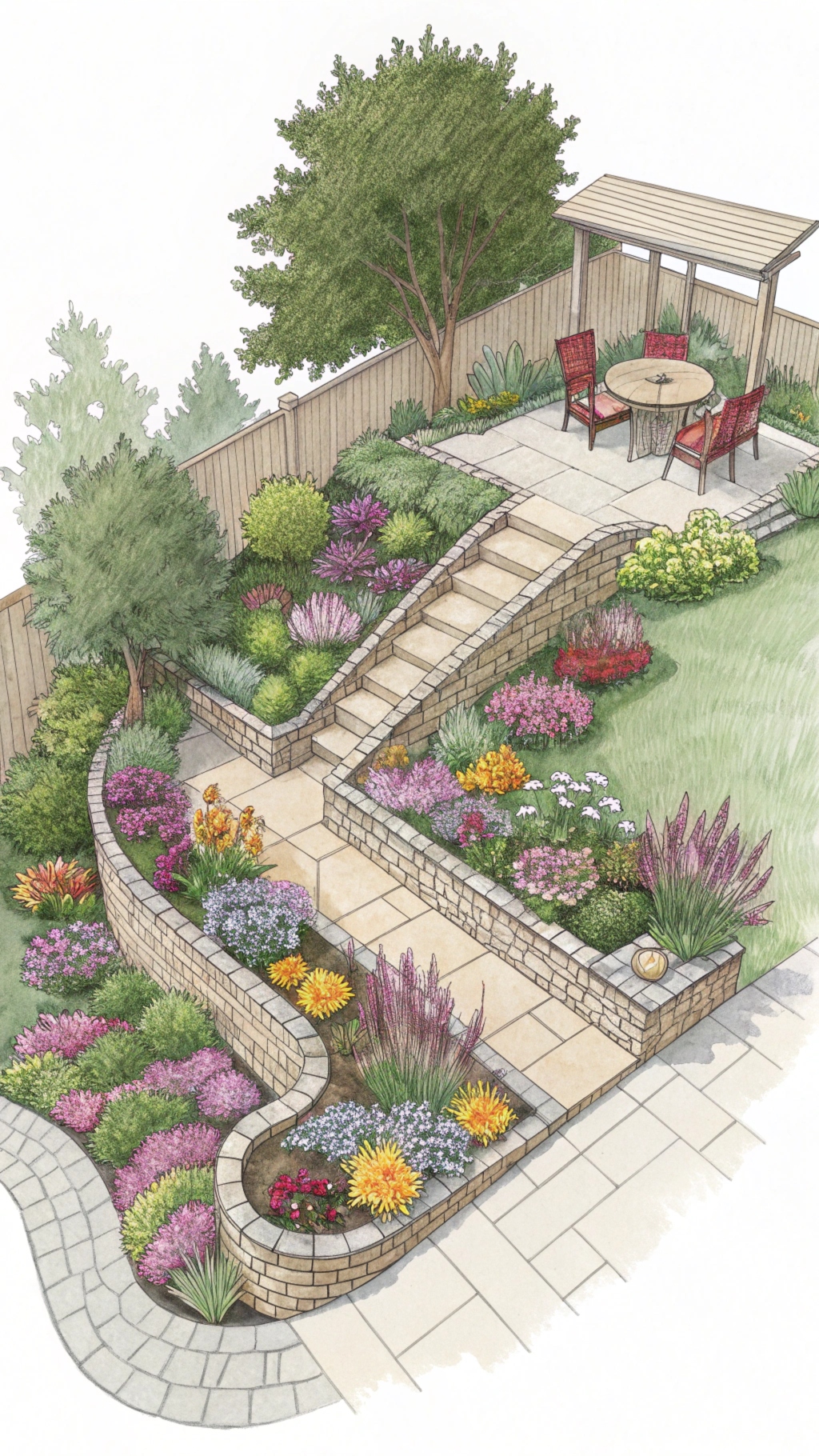
Site Assessment
Before diving into construction, it’s essential to evaluate your yard’s natural features. A proper site assessment lays the foundation for a successful tiered garden by ensuring the design complements the terrain.
- Slope and Elevation: Observe the gradient of your yard. Is it a gentle slope or a steep incline? The steepness will dictate the number and height of tiers needed. For mild slopes, two or three levels may suffice, while steeper yards may require more.
- Soil Type: Understanding the soil’s composition is critical for planting and structural stability. Sandy soil may require reinforcement, while clay-heavy soil might need improved drainage. Conduct a simple soil test to identify its pH and nutrient levels.
- Sunlight Exposure: Monitor the sun’s movement throughout the day. Tiered gardens benefit from strategic plant placement—sun-loving plants flourish on upper tiers, while shade-tolerant varieties thrive lower down.
- Water Drainage: Assess how water flows through the slope during rain. Proper drainage prevents water from pooling at the base of the garden and ensures plants on higher tiers receive adequate moisture.
Spending time on site assessment helps prevent costly mistakes and ensures your tiered garden works harmoniously with the land.
Sketching the Layout
Once you understand your yard’s characteristics, the next step is sketching a layout that brings your vision to life. A thoughtfully designed plan ensures that your tiered garden is not only beautiful but also functional.
Tips for Drawing Your Garden Plan
- Define Your Tiers: Use your yard’s natural contours to determine where each tier will go. Start by marking the highest and lowest points, then divide the slope into manageable sections.
- Incorporate Paths and Steps: Make sure to include access points in your design. Steps, ramps, or gravel paths provide easy movement between tiers and add visual flow.
- Identify Focal Points: Decide where you want the eye to be drawn. A water feature, sculpture, or a striking plant arrangement can serve as the centerpiece.
- Choose Plant Zones: Group plants by their light and water needs. For example, drought-tolerant plants work well on the highest, sunniest tiers, while moisture-loving species thrive at the bottom.
- Consider Maintenance Needs: Allocate space for tools, compost bins, or water access points to make upkeep easier.
Creating a detailed sketch helps you visualize your garden before construction begins. It also allows for adjustments to ensure the design is practical and suited to your yard’s needs.
Tiered Garden on a Hill
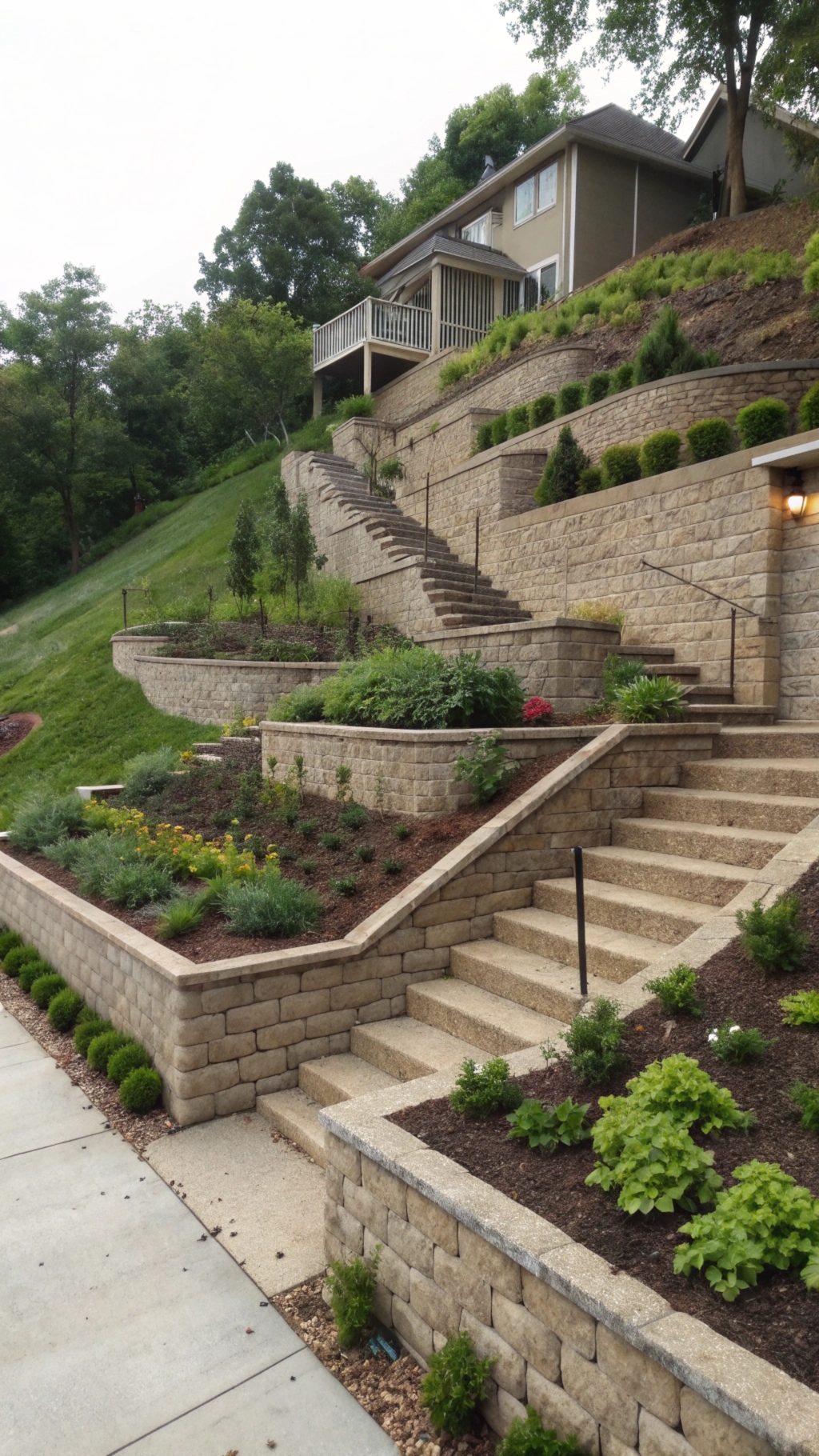
Designing for Steep Slopes
Gardening on a hill presents unique challenges, but the right design techniques can turn a steep slope into a stunning tiered garden. Terracing is one of the most effective methods for managing steep inclines.
Techniques for Terracing
- Retaining Walls: Use sturdy materials like stone, concrete blocks, or treated wood to build retaining walls for each tier. These walls stabilize the soil and provide a clean, structured look.
- Gradual Elevation: Instead of steep, abrupt tiers, aim for gradual transitions. This reduces erosion and creates a more natural appearance.
- Integrated Steps: Incorporate steps into the terracing for a seamless transition between levels. Stone steps or wooden sleepers blend well with the garden’s aesthetic.
- Erosion Control Measures: Install geotextile fabric or mulch to prevent soil from washing away while plants establish their roots.
Plant Selection for Slopes
Choosing the right plants is crucial for stabilizing the soil and adding beauty to the garden. Focus on hardy, low-maintenance species that thrive on slopes.
- Groundcovers: Creeping thyme, vinca, and sedum spread quickly, providing excellent erosion control while adding lush greenery.
- Ornamental Grasses: Varieties like fountain grass or blue fescue have deep root systems that anchor the soil and sway gracefully in the breeze.
- Native Plants: Indigenous species are often better adapted to local conditions, requiring less water and care.
- Flowering Shrubs: Plants like hydrangeas or lavender add vibrant color while holding the soil in place.
Planting in clusters or drifts creates a cohesive look and minimizes bare spots, which can lead to erosion.
Irrigation for Hillside Gardens
Watering can be tricky on slopes, as water tends to run downhill. Drip irrigation systems are ideal, delivering moisture directly to plant roots and conserving water. Mulching each tier also helps retain moisture, keeping plants healthy during dry spells.
Creating an Accessible Tiered Garden
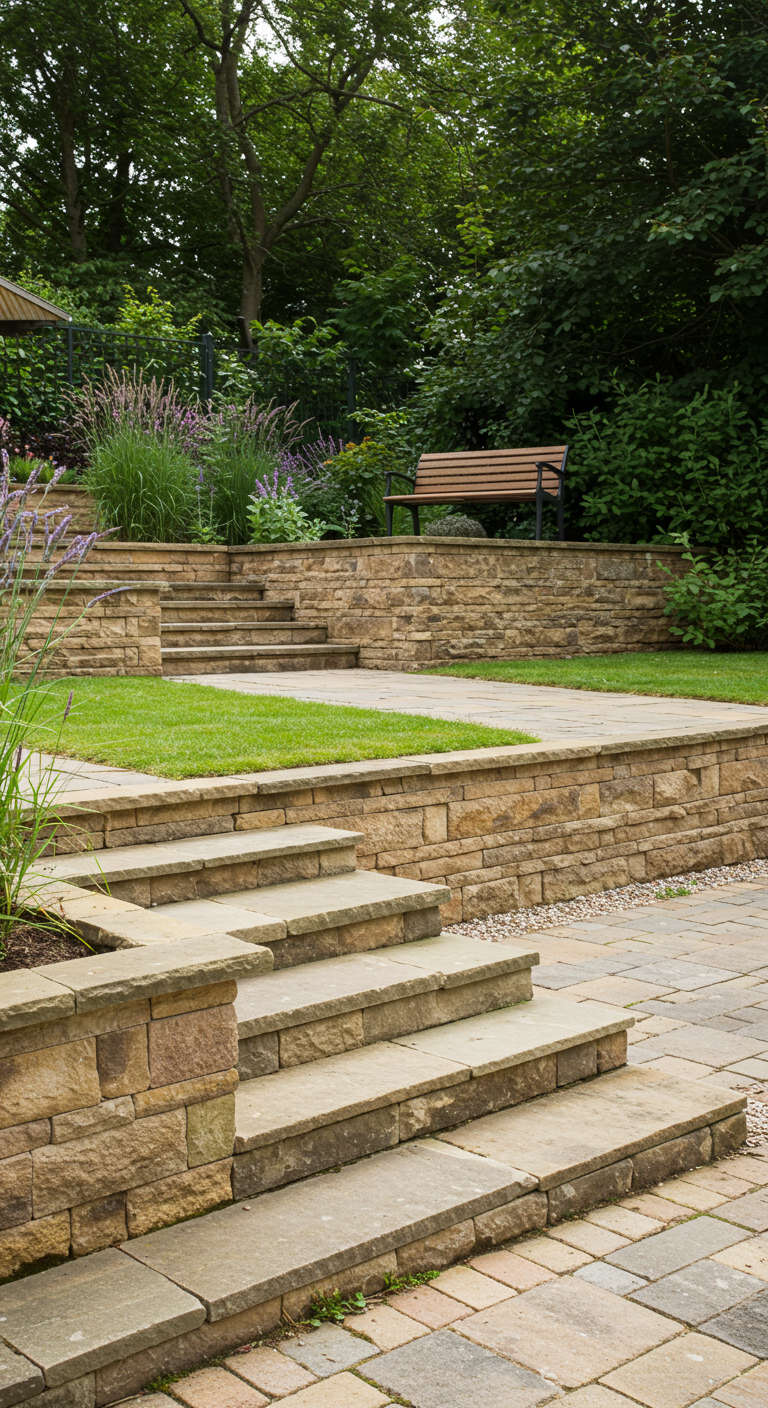
Accessibility Features
A well-designed tiered garden should be easy to navigate and maintain, allowing everyone to enjoy its beauty. Incorporating accessibility features ensures that the garden is functional for individuals of all ages and mobility levels.
Adding Paths and Steps
- Wide, Stable Steps: Design steps with a width of at least 36 inches to provide enough space for walking or carrying tools. Use materials like stone, concrete, or treated wood for durability.
- Gentle Inclines: For steep areas, ramps with a gentle slope make the garden accessible to wheelbarrows or individuals with mobility aids.
- Non-Slip Surfaces: Opt for materials that offer good traction, especially in wet weather. Gravel paths, textured pavers, or rubber matting work well.
Rest Areas
Include flat platforms or seating areas at strategic points in the garden. Benches or even a small patio space at the mid-tier or top level provide places to rest and enjoy the view.
Lighting for Safety
Install pathway lighting to enhance visibility during evening hours. Solar-powered lights are an eco-friendly option and can be easily positioned along paths or steps.
DIY vs. Professional Help
When deciding whether to take on your tiered garden project yourself or hire professionals, consider the complexity of the design and your skill level.
When to DIY
- Simple Designs: If your slope is mild and the tiers are straightforward, a DIY approach can save money.
- Small-Scale Projects: Gardens with two or three tiers and no complex features like retaining walls are ideal for DIY.
- Budget Constraints: Building with recycled materials or low-cost options, like timber or bricks, is manageable for most homeowners.
When to Hire Professionals
- Steep Slopes: Significant inclines require expert knowledge to construct stable retaining walls and manage drainage effectively.
- Structural Features: Adding elements like water features, heavy stone walls, or multi-level irrigation systems often requires professional expertise.
- Time Constraints: If you lack the time to dedicate to a large project, hiring professionals ensures the garden is completed efficiently.
Balancing accessibility and design ensures a tiered garden is not only stunning but also easy to maintain and enjoy for years to come.
The Aesthetic of Tiered Cottage Gardens

Cottage Garden Charm
Tiered gardens and cottage gardens are a match made in heaven. The lush, overgrown look of a cottage garden works beautifully when applied to tiered designs, creating a whimsical yet structured aesthetic.
Blending Cottage Style with Tiers
- Layered Abundance: Fill each tier with a mix of flowering perennials, climbers, and shrubs to achieve a full, layered effect.
- Curved Borders: Incorporate gentle, flowing lines for the edges of tiers rather than rigid, straight lines. This adds to the natural, informal feel.
- Mix of Heights: Combine plants of various heights and textures for a dynamic and visually engaging garden.
Plant Choices for Cottage Tiered Gardens
Choosing the right plants is essential for capturing the charm of a cottage garden while maximizing the tiered structure.
- Perennials: Lavender, delphiniums, and daisies provide reliable blooms and return year after year.
- Climbing Plants: Roses, clematis, and wisteria add vertical interest, trailing beautifully over the edges of each tier.
- Flowering Shrubs: Hydrangeas, lilacs, and forsythias create lush backdrops for lower tiers.
- Seasonal Annuals: Add vibrant pops of color with marigolds, petunias, or snapdragons.
Enhancing the Cottage Feel
- Rustic Features: Use natural stone or weathered wood for retaining walls to complement the relaxed cottage style.
- Vintage Accents: Include decorative items like iron trellises, birdhouses, or antique watering cans to enhance the garden’s charm.
Combining the structured elegance of tiered gardens with the untamed beauty of cottage gardens results in a space that feels both timeless and magical.
Budget-Friendly Tiered Garden Ideas for Sloped Yards
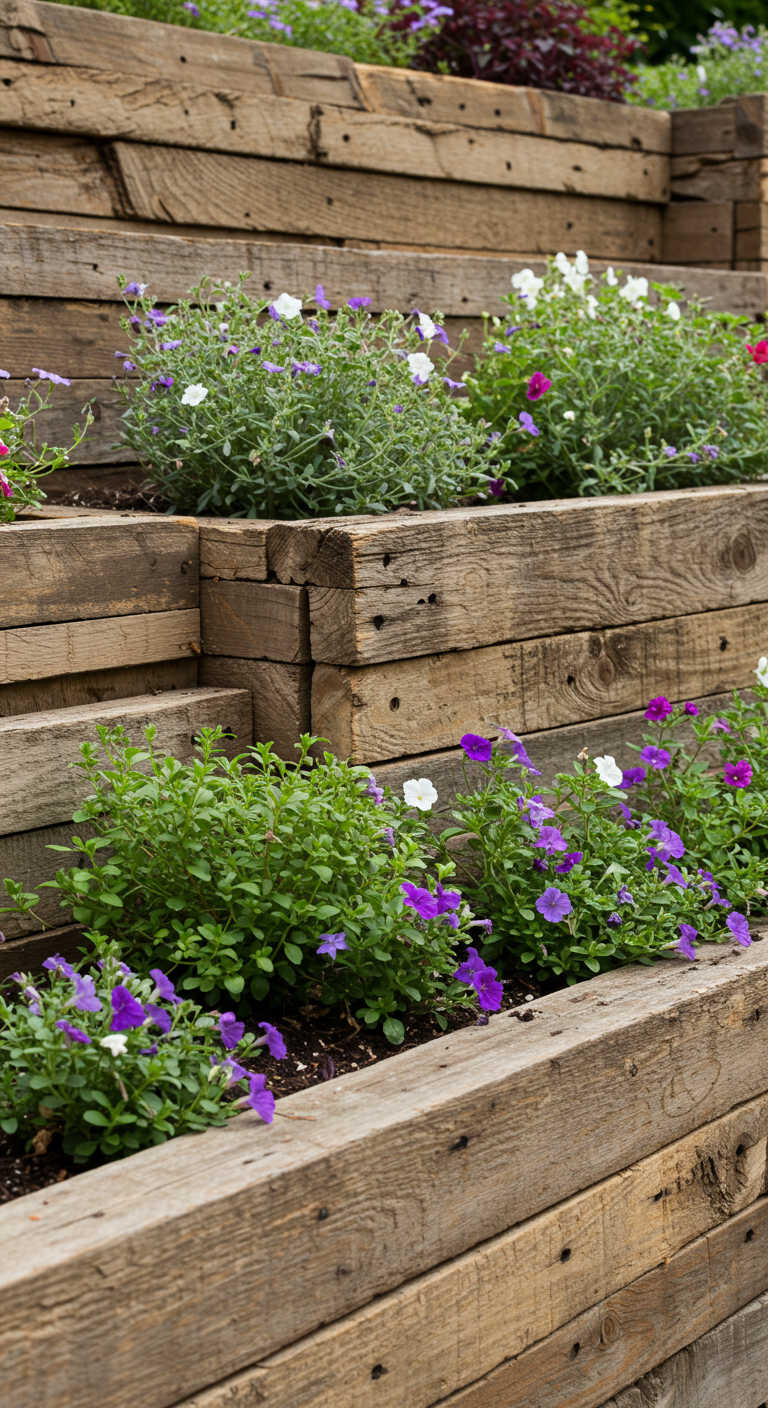
Utilizing Cheap Materials
Creating a stunning tiered garden doesn’t have to break the bank. With a little creativity, you can build beautiful terraces using recycled or inexpensive materials.
Recycled Materials
- Old Bricks: Repurpose bricks from previous projects or salvage yards. They make sturdy and attractive retaining walls.
- Wooden Pallets: Pallets can be disassembled and used for edging or building planter boxes. Treat the wood to prevent rot and extend its lifespan.
- Concrete Blocks: Affordable and easy to stack, concrete blocks provide excellent stability and can be arranged creatively to form tiers.
- Tires: Stack old tires to create rounded tiers. Paint them for a polished look, and fill them with soil and plants.
Natural Elements
- Logs and Stumps: Use logs as borders for each tier, and place stumps as decorative seating or planters.
- Rocks and Stones: Collect stones from your property or nearby areas to build retaining walls or pathways. Natural stones blend seamlessly into the landscape.
Growing Your Own Plants
Save on plant costs by propagating your own greenery. This method not only reduces expenses but also gives your garden a personal touch.
- Cuttings: Grow shrubs, vines, or perennials from cuttings. For example, rosemary and lavender are easy to propagate.
- Seeds: Purchase seed packets instead of fully grown plants. This is a cost-effective way to fill your tiers with annuals and perennials.
- Dividing Plants: Divide established perennials, such as hostas or daylilies, to spread them across multiple tiers.
Tips for Budget-Friendly Maintenance
- Mulching: Mulch helps retain moisture, reducing water usage and keeping weeds at bay. Use shredded leaves, grass clippings, or wood chips from your yard.
- DIY Compost: Create your own compost to enrich the soil without spending money on store-bought fertilizers.
With resourceful material choices and smart planting strategies, you can create a stunning tiered garden on any budget.
Innovative Tiered Garden Features
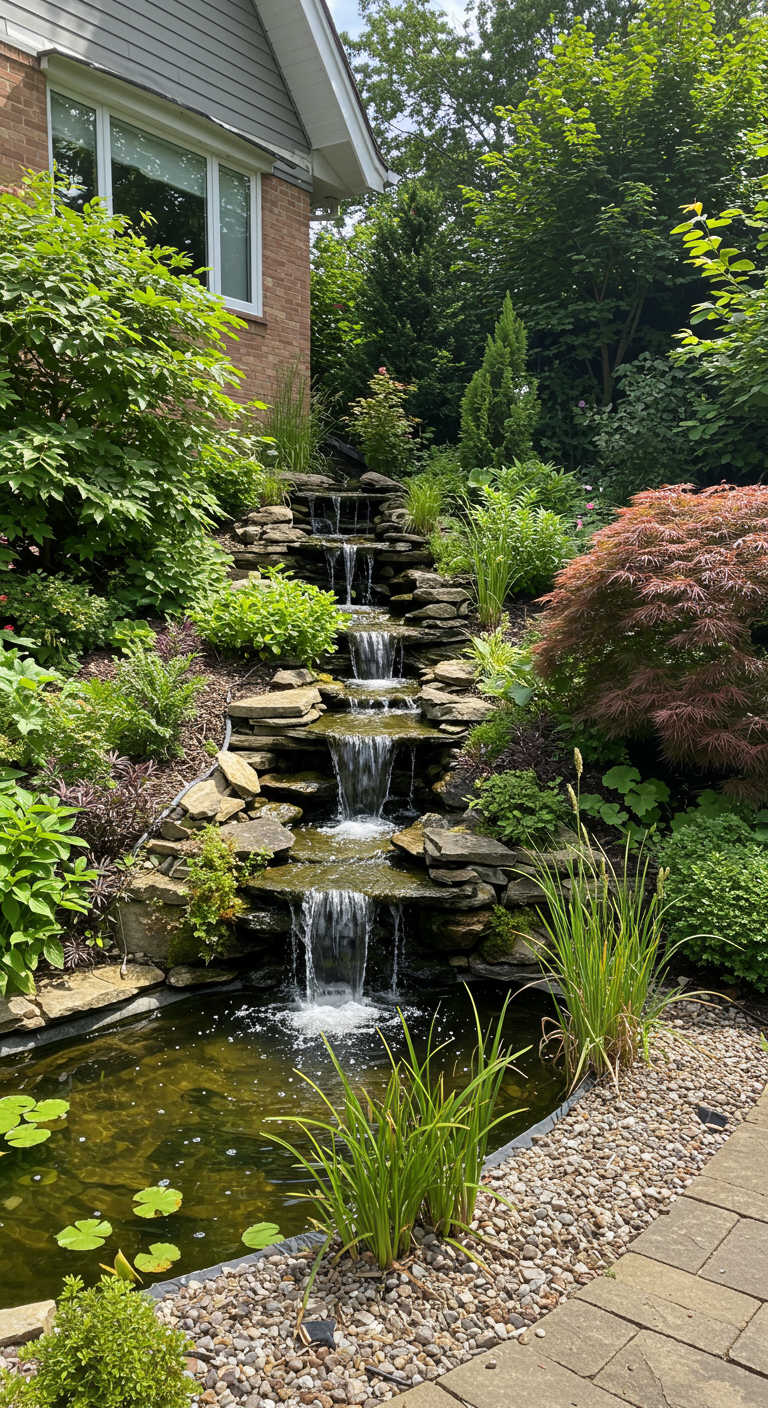
Incorporating Water Elements
Adding water features to a tiered garden elevates its beauty and creates a calming atmosphere. Flowing water can also connect the tiers visually and audibly, enhancing the garden’s overall appeal.
Ideas for Water Features
- Small Ponds: Install a pond on the lowest tier as a focal point. Surround it with moisture-loving plants like ferns and irises for a natural look.
- Waterfalls: Create a cascading waterfall that flows down multiple tiers. Use rocks or concrete forms to shape the flow.
- Water Channels: Add narrow channels or streams that run between tiers, directing water naturally through the garden.
Benefits of Water Features
- Wildlife Attraction: Birds, frogs, and insects are drawn to water, making your garden more dynamic and vibrant.
- Cooling Effect: Water features help cool the surrounding area, especially during hot summer months.
- Stress Relief: The sound of running water provides a soothing backdrop, enhancing relaxation.
Lighting and Art

Tiered gardens are equally enchanting at night with the right lighting and artistic touches.
Garden Lighting
- Pathway Lights: Place solar-powered lights along paths and steps to guide visitors after dark.
- Uplighting: Highlight architectural features, like retaining walls or tall plants, with soft uplighting.
- String Lights: Drape string lights along railings or trellises for a whimsical, festive ambiance.
Sculptures and Art Pieces
- Garden Sculptures: Add unique sculptures or statues to draw attention to specific areas.
- DIY Art: Paint rocks, repurpose metal objects, or craft wind chimes to reflect your style.
- Functional Decor: Use decorative items like rain chains or colorful pots to blend art with functionality.
With innovative features like water elements and lighting, your tiered garden can become a vibrant, multi-sensory space.
High-Tiered Garden Inspirations
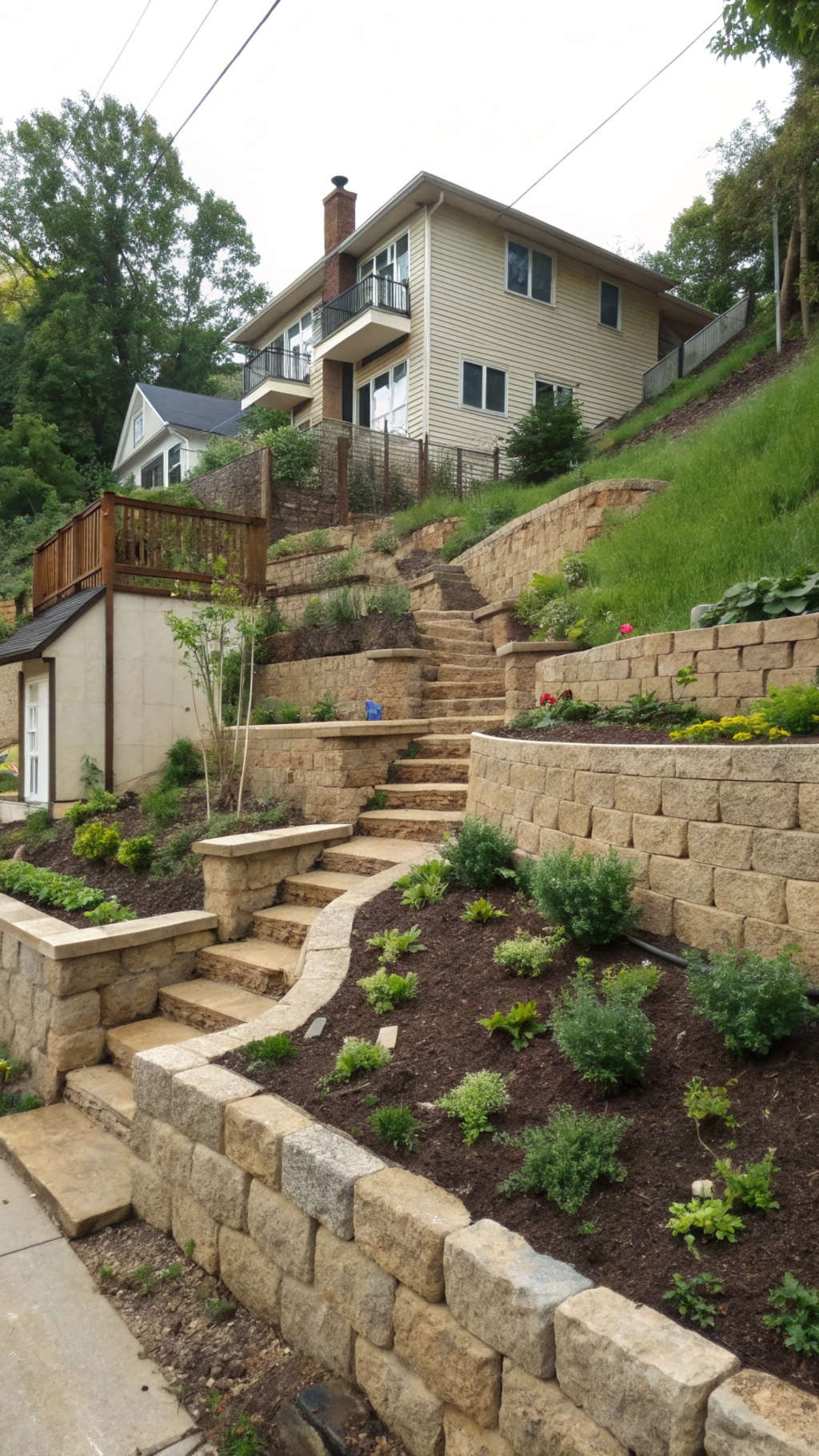
Vertical Planting
Maximizing vertical space in a tiered garden is a fantastic way to add depth, texture, and functionality. Vertical planting works particularly well in gardens with limited ground space but ample height.
Ideas for Vertical Planting
- Hanging Baskets: Suspend baskets filled with cascading flowers like petunias, lobelia, or ivy along trellises or walls. This draws the eye upward and adds layers of color.
- Espalier Trees: Train fruit trees like apple or pear to grow flat against a wall or trellis. This technique saves space and provides a productive, decorative feature.
- Climbing Plants: Add trellises or arbors to your tiers for climbing plants like clematis, jasmine, or morning glory. These create lush walls of greenery and blossoms.
- Stacked Planters: Use stacked pots or tiered shelves to create a vertical garden for herbs, succulents, or small flowers.
Benefits of Vertical Planting
- Space Efficiency: Ideal for narrow gardens or small yards.
- Increased Yield: Grow more plants in a smaller footprint, especially useful for herbs and vegetables.
- Visual Impact: Adds layers of interest, making the garden feel fuller and more dynamic.
Designing Viewpoints
Tiered gardens offer a unique advantage: they can be designed to provide stunning views from various angles and elevations.
Creating Focal Points
- Seating Areas: Incorporate benches or small patios on upper tiers to create lookout spots. These areas are perfect for enjoying a panoramic view of the garden.
- Plant Groupings: Use color-coordinated plants or striking textures to create visual interest when viewed from above or below.
- Artistic Elements: Place statues, water features, or decorative items strategically to catch the eye from different perspectives.
Multi-Level Walkways
Design paths that wind through the tiers, offering different vantage points. Materials like stepping stones, gravel, or wooden planks enhance the natural aesthetic while guiding visitors through the garden.
Lighting for Nighttime Views
Highlight viewpoints with soft lighting, such as lanterns or low-voltage LED fixtures. This transforms the garden into a magical space after sunset.
DIY Tiered Garden Construction
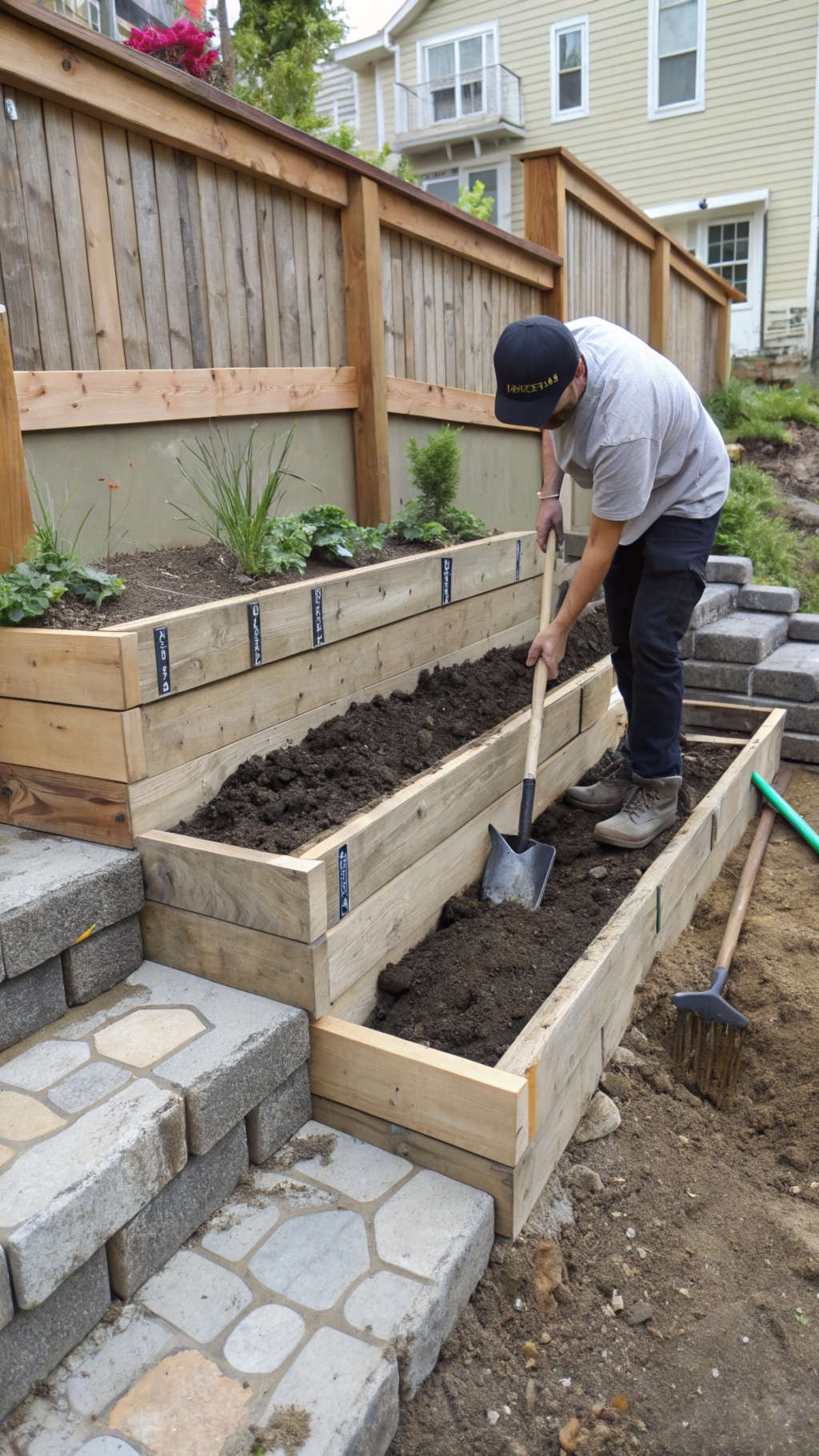
Step-by-Step Guide
Building your own tiered garden is a rewarding project that can be customized to suit your needs and budget. Here’s a simple guide to get you started:
- Plan the Design: Sketch out your garden’s layout, including the number of tiers, retaining walls, and access points.
- Gather Materials: Choose materials for retaining walls, such as stone, concrete blocks, or treated wood. Collect soil, mulch, and plants.
- Mark the Area: Use stakes and string to outline where each tier will be built.
- Start at the Bottom: Begin with the lowest tier. Dig into the slope to create a level area and install retaining walls.
- Work Upwards: Gradually move up the slope, building each tier and its retaining wall. Ensure proper drainage by angling walls slightly inward.
- Add Soil and Plants: Fill each tier with nutrient-rich soil and plant according to your design. Group plants by their water and sunlight needs.
- Finish Paths and Steps: Install paths, steps, or ramps for easy access between tiers.
Common Mistakes to Avoid
- Ignoring Drainage: Poor drainage can lead to water pooling and soil erosion. Incorporate proper irrigation systems and drainage channels.
- Unstable Walls: Use sturdy materials and reinforce walls with anchors or supports to prevent collapse.
- Overcrowding Plants: Leave enough space for plants to grow without competing for sunlight or nutrients.
Tools and Safety Tips
- Essential Tools: You’ll need a shovel, level, wheelbarrow, and measuring tape. For retaining walls, consider using a compactor or tamper.
- Safety Precautions: Wear gloves, sturdy shoes, and protective eyewear. Take care when lifting heavy materials to avoid injury.
You should bear in mind that building a tiered garden can be labor-intensive. However, on the flip side, the results are generally worth the effort. The finished product is a functional, beautiful space that enhances your yard.
Maintenance and Care
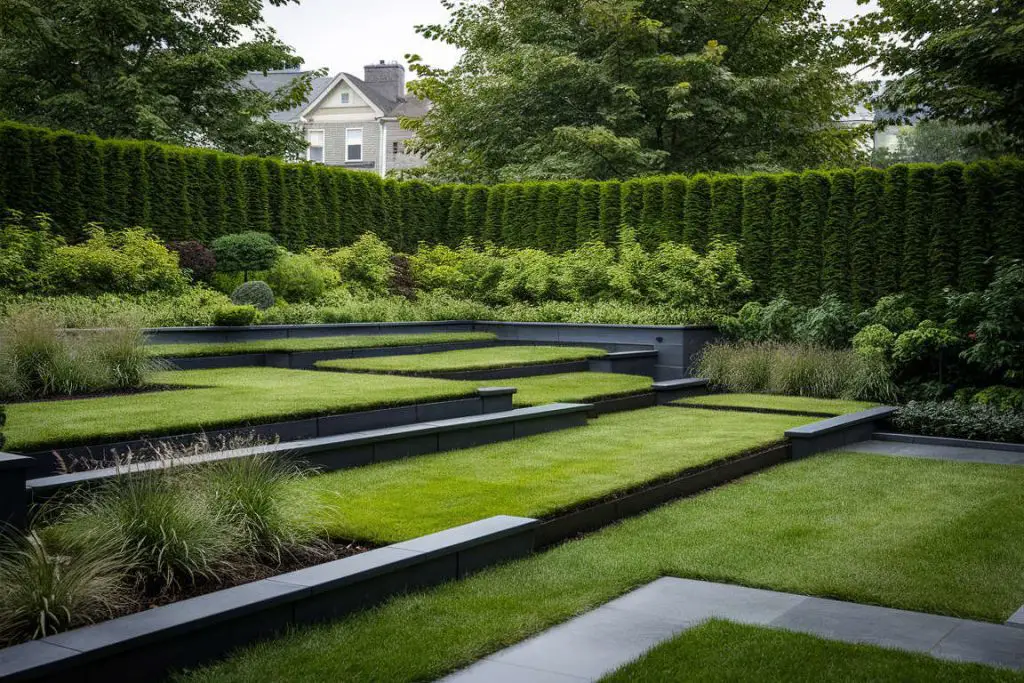
Seasonal Care
Tiered gardens, like any landscaping feature, require consistent maintenance to remain healthy and visually appealing. Seasonal care ensures plants thrive year-round and the structural integrity of your tiers is preserved.
Spring
- Plant Inspection: Check for winter damage and replace plants that didn’t survive.
- Soil Enrichment: Add compost or organic matter to refresh the soil and prepare it for new growth.
- Mulching: Apply a fresh layer of mulch to retain moisture and suppress weeds as temperatures rise.
Summer
- Irrigation: Monitor water needs closely, especially during dry spells. Drip irrigation systems are ideal for consistent moisture.
- Pest Control: Watch for common pests like aphids or slugs and address them with eco-friendly solutions.
- Deadheading: Remove spent flowers to encourage more blooms and maintain a tidy appearance.
Fall
- Pruning: Trim back perennials and shrubs to prepare them for dormancy.
- Leaf Removal: Clear fallen leaves to prevent rot and maintain neatness.
- Winter Preparation: Protect sensitive plants with burlap or frost covers and ensure retaining walls are secure.
Winter
- Structural Checks: Inspect retaining walls and pathways for damage caused by freeze-thaw cycles. Repair cracks or shifts promptly.
- Snow Management: Avoid piling heavy snow on tiers to prevent structural stress.
By tailoring care to each season, your tiered garden will remain healthy and visually appealing year-round.
Long-Term Upkeep
While daily or weekly tasks keep your garden looking fresh, long-term maintenance ensures its longevity.
Soil Health
Over time, soil in tiered gardens can compact or deplete nutrients. Periodically aerate the soil and add compost or organic fertilizer to maintain fertility.
Retaining Walls
- Regular Inspections: Check walls for cracks, leaning, or erosion around the base.
- Reinforcements: Add supports or rebuild sections if structural issues arise. Using durable materials like stone or concrete reduces the need for frequent repairs.
Plant Replacements
Plants in tiered gardens may outgrow their space or decline over time. Plan for occasional replacements to keep the garden vibrant. Choose hardy, low-maintenance plants to minimize future effort.
Drainage Systems
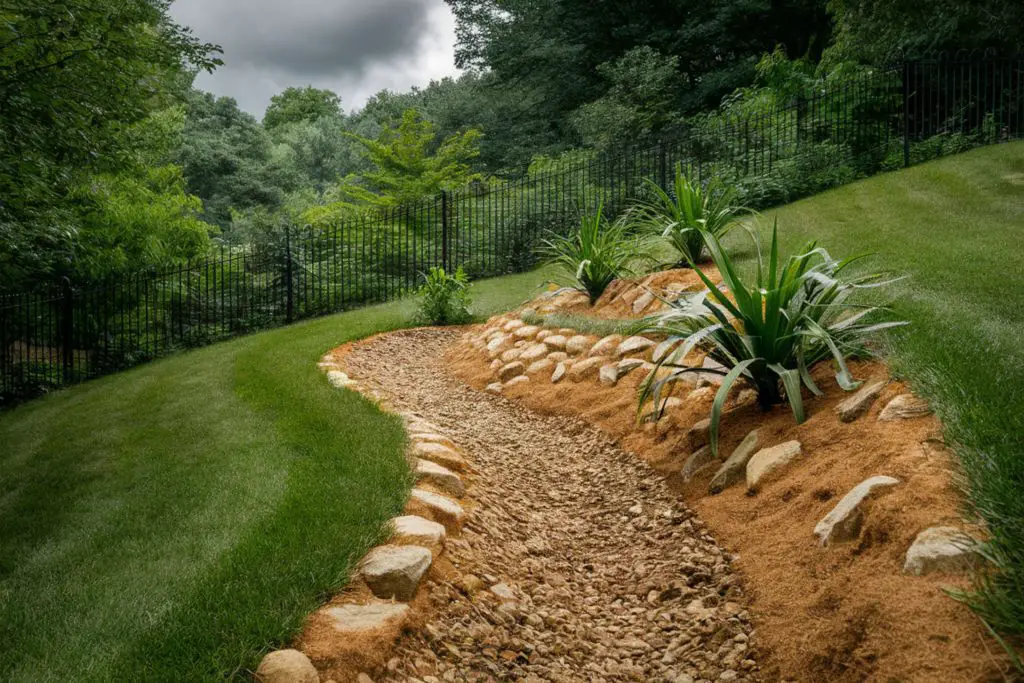
Ensure drainage systems, such as channels or pipes, remain clear of debris. Proper drainage prevents waterlogging and protects the integrity of your tiers.
Consistent long-term care not only keeps your garden looking beautiful but also preserves the time and effort you invested in creating it.
Wrap-Up
Tiered gardens are a blend of functionality and beauty, transforming even the most challenging slopes into stunning outdoor spaces. From improving soil stability to maximizing planting opportunities, these gardens offer a practical solution for sloped yards while adding depth and visual interest.
Throughout this article, we’ve explored the many ways to design, build, and maintain a tiered garden. Whether you’re working on a budget, incorporating unique features like water elements, or creating a cottage-style haven, tiered gardens can be tailored to fit any vision or yard size.
Next Steps
Ready to get started? Gather inspiration from local gardens, books, or online resources. Explore community workshops or hire a professional for complex projects. With creativity and planning, your dream tiered garden is within reach.
A tiered garden isn’t just a landscaping feature—it’s a personal retreat, a showcase for your favorite plants, and a lasting investment in your outdoor space. Let your imagination take the lead, and watch as your yard transforms into a captivating masterpiece.
